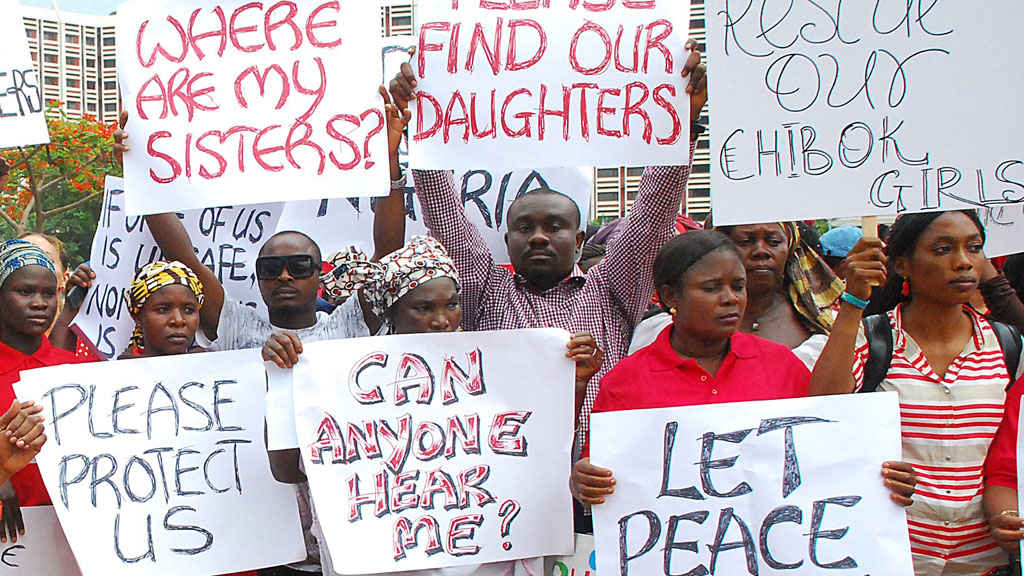Nigeria schoolgirl kidnappings – what is going on?
Confusion and a lack of information have dominated the Nigerian schoolgirl kidnapping crisis something that one expert says plays into militant group Boko Haram’s plans.

Boko Haram burst back onto the scene in 2011 – and its campaign of violence has escalated in 2014, with more than 1,500 dead in the group’s attacks, according to Amnesty International.
Boko Haram has capitalised on the communications problem. Elizabeth Donnelly, Chatham House
It took 20 days for Nigeria’s President Goodluck Jonathan to comment publicly on the kidnappings, and the period before this was marred by conflicting reports on the number of girls missing and the number that had been rescued.
A problem for Nigeria is a poor information-sharing network within the country – coupled with an element of distrust between Nigeria’s government in Abuja, the country’s capital, and the northern states, says Elizabeth Donnelly, assistant head of Chatham House‘s Africa programme.
“Boko Haram has capitalised on the communications problem,” she told Channel 4 News. It is an organisation that thrives on mystery, she added, and has an effective PR machine.
How many missing?
The number of missing schoolgirls has varied dramatically since their kidnapping on 14 April. On 15 April a teacher said “more than 100” female students had been taken from the school in Chibok, in the north eastern Borno state.
A day later, Nigeria’s military said most of the 100 females had been rescued, only for this to be denied by the government of Borno State the day after that.
It was not until a week after the disappearances that the much higher figure of 234 missing children was claimed by the girls’ parents.
Read more: Boko Haram - using terrorism to bring sharia to northern Nigeria
Nigeria’s police currently says that 274 schoolgirls are missing, and that 53 have been freed.
Ms Donnelly said that the confusion over numbers highlights a wider problem of “poor governance” that means reliable information is hard to come by.
On Monday, the Northern States Christian and Elders Forum, a group of Christian leaders, released a list of 180 names of girls they said had been taken by Boko Haram.
Why are schools being targeted?
On Tuesday, two further schools were reported to have been attacked, and eight schoolgirls kidnapped.
The eight schoolgirls were kidnapped from a rural village, Warabe, approximately 70 miles from Chibok where the 14 April kidnappings took place.
Rural attacks, Ms Donnelly says, are a sign of how Boko Haram has “adapted””.
“Last year a state of emergency was declared in three northern states,” she said. “That drove many active members of Boko Haram out of urban centres.”
As a result of this, Ms Donnelly says, the group began focusing on rural locations and hitting “softer targets, like schools”.
Additionally, the name Boko Haram means “western education is forbidden”, and the group opposes the education of women. Boko Haram has previously called for teachers and schools to be targeted.
North-south divide?
There is growing anger in Nigeria at the government’s response to the latest Boko Haram attack, and protests have taken place in the north east, Lagos and Abuja.
Part of the problem, Ms Donnelly says, is a disparity between the government and its “southern” president Goodluck Jonathan, and the more economically disadvantaged north of the country.
Ms Donnelly says there is an element of distrust between Abuja and the northern states, and that the president has “not managed relations with the north”. This, she said, coupled with the lack of information, has slowed the government’s response.

The “distrust” may also be a factor in the arrest of a protester at the weekend. Naomi Mutah Nyadar was taken to a police station in Abuja after meeting, along with fellow protesters, with Nigeria’s first lady, Patience Jonathan.
A presidency source said the woman had been detained because she had falsely claimed to be the mother of one of the missing children. Lawan Abana, another protester, said Ms Nyadar had not made such a claim.
Patience Jonathan has denied local media reports that she had ordered the arrest.
Why are they hard to find?
Boko Haram is a borderless group that could have taken the schoolgirls to a number of locations within an area of approximately 65,000 square miles – crossing the borders of Cameroon, Chad and Niger.
One of their known hideouts in the area is the Sambisa Forest Reserve – a colonial-era game reserve now taken over by the militant group.
The forest includes dense wooded areas characterised by thorned vegetation. It has been suggested that foreign help could involve using drones to locate Boko Haram – but this could be problematic when searching such a densely covered location.
Additionally, the militants could have left Nigeria. In Cameroon’s north, for example, a senior Boko haram commander, Mamman Nur, is known to operate.